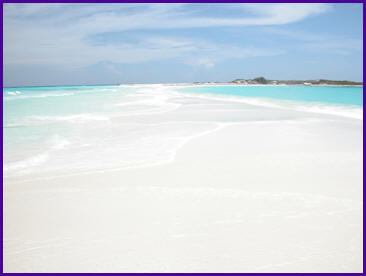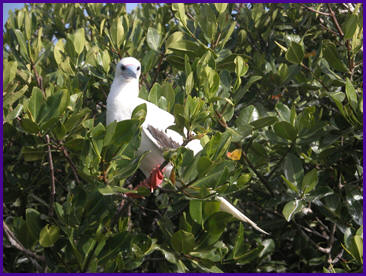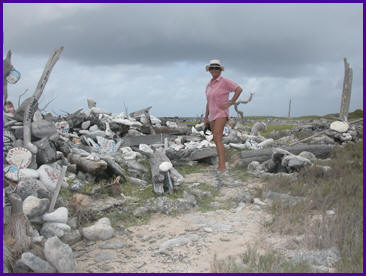

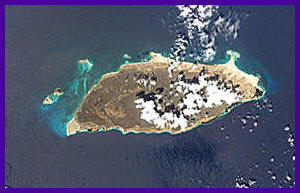 |
May 2010 - There was virtually no wind so we motored slowly 60
miles north towards our first stop Isla Tortuga, so named because it
allegedly resembles a turtle. Well here's the picture, what do you
think? Tortuga was reputed to be far enough from land and far enough off the beaten track
to be free of pirates/drug runners/etc. Actually, we motored more
and more slowly all the time because our engine was overheating.
Also, our rudder indicator was buzzing and leaping round the dial, our
compass had developed a large bubble in the middle of the sight glass,
and as we were to find out as soon as we started it, our generator
was also about to fail. Pretty good start! Before we could get to grips with any of this stuff properly, we needed to get ourselves anchored, and before that we had to play the "Let's not run the boat aground on the reef" game! Now normally this isn't too much of a problem given accurate charts and GPS, but as we started to turn the northern tip of the island it was apparent that something was radically wrong. The depth was dropping away and the rocks were looking awfully close. Also the 50 ft yacht which we had taken to be at anchor was now, quite clearly aground on the reef! |
|
Hard to starboard and run away from land whilst we digested the situation, then back to old fashion eyeball navigation and another 30 minutes saw us edging carefully into the anchorage and dropping the hook in 3 meters in front of Playa Caldera, a long white sandy beach with just a small handful of fisherman's shacks. It was now clear that the island was charted about quarter of a mile further south than the reality. The yacht we saw on the reef, which looked only to have been there for a few weeks at most, had obviously been coming in like us using GPS co-ordinates and either because it was dark or for some other reason hadn't noticed the problem in time with disastrous results. We'd been lucky! |
|
| First job fix the overheating. Crud in the heat
exchanger - perennial problem. Surely you should have cleaned it
out before you left PLC you're asking. Lindy was asking the same
question! Well it's a difficult knuckle skinning job that takes a
full day and so is always worth putting off. Disconnected and
remade all the rudder indicator connections and that was fixed -
nautical environment and electronics always such an excellent mixture!
No idea what to do about the bubble in the compass, no idea what liquid
they use. I'll learn later that Gin works well, but for the time
being we just put it on the "To Do" list. Now as we're beginning to relax, it's time to start the genset, and for it to overheat and shut down almost immediately. It's a long story but there's crud in the cooling galleries of the head and cylinder block, which will entail removing both - many many times over the next several weeks! Then, whilst I've got my head buried in the genset Lindy calls from the cockpit - "There's a pirogue coming towards us with two guys on board". This is a moment we've been dreading. Anywhere else you'd think nothing of a situation like this, but in Venezuela the "Have you got any water?" approach has become one of the standard ways for pirates to get in close to a yacht before they draw their weapons. The lady we met in PLC, whose husband had been murdered, fell foul of just such an approach. The difficult call of course is to try and tell the good guys from the bad guys. So I come up on deck covered in oil, extremely tense and watching for any kind of movement which will have me diving below like a shot (sic). But it was OK. They approached slowly and the closer they got the more clear it became that they had no weapons and nowhere to hide them. What they had was a problem with an outboard and what they needed was a 13mm socket and a suitable wrench and some vice grips. No problem we had all of these, and they could borrow them, but as they could see (showing them my hands) I'm working on my generator at the moment and I need the tools myself. If they were to come back in a couple of hours they could borrow what they needed. They were more than happy with that and departed waving and smiling. They were back in about 20 minutes - Couldn't they tell the time? or was the first trip just a softening up exercise and now they'd come back with the guns? No what they'd come back with was a freshly boiled lobster for our lunch. They'd return later to borrow the tools when we'd eaten and taken a suitable siesta. And they did, a couple of times as their job became more problematic (we know that feeling) and they needed more tools. They were 100% honest, and when they came for the last time to return the final bits and pieces, we'd had time to delve into the bilge and find a couple of old spanners that they could keep. Did we want more lobsters they wanted to know, holding up a couple from the bottom of the boat. No really, thanks, but one lobster a day is enough! |
|
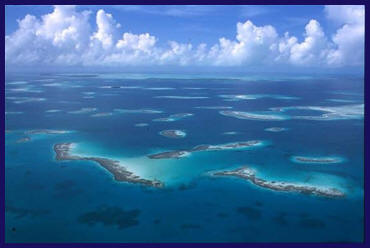 |
Well after a day or two the charms of Tortuga began
to wane so at 6.00 in the evening (with a still limping generator, which
would be a feature of our lives for what would come to seem like
forever) we hauled our anchor for the hundred or so mile trip NW to the
Los Roques archipelago, a collection of reefs and coral islands set in
the middle of the sea, sheltered from the prevailing wind and sea behind
a 15 mile long barrier reef, and said to be one of the wonders of the
Caribbean. The words coral and reef are both operative here hence
the timing of our departure, so as to arrive at the entrance to Los Roques at around midday, when the sun would be at its' zenith and the
visibility through the water would be optimum. We'd been told the Los Roques entrance was reasonably straight forward with good light as long as there was no swell. Conditions should be perfect, but you never know. Well, entering the first reef was livelier than we would have wished and that was with practically no sea running at all. Once inside we were in beautifully flat turquoise water. All we had to do was identify the second reef and turn to starboard just before it - in order to follow the deep channel that continued for the next ten miles or so until we found a spot we liked where we could drop the hook. |
| No problem, except we managed to sail blithely through
the second reef without realising it. There wasn't even supposed
to be a channel, but we'd found one. We had also found a wonderful
mess of reefs, rocks and shallows without the proverbial room for cat
swinging! Well, with much back and forth and peering over the side
we finally retraced our steps into, what was now blindingly obvious, the
main channel. Much, much wider and much easier to find than we'd
ever imagined. We'd been looking for something much more tricky. A few miles further north we dropped anchor in turquoise water behind Buchiyaco, a tiny mangrove island, just off the barrier reef. With the waves breaking on the other side of the reef and enough wind to keep us cool and the mosquitoes away, the wind generator turning and not another human being in sight - it was wonderful! The following morning a small boat ran itself up on the reef in front of us and the occupants stepped out onto the reef in waders to go fly fishing. Not something we'd ever expected to see in the Caribbean, but as we were to observe quite a big thing in Los Roques. Another sailing boat, Dutch, also anchored nearby. |
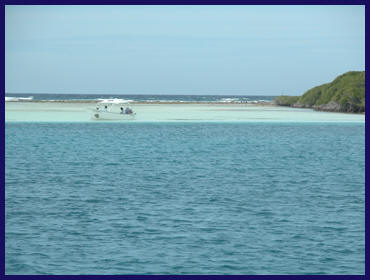 |
| We were also able to see from our anchorage a small red steel German yacht that had fetched up on the outer reef after it had been boarded by pirates off the coast of Venezuela. They shot and killed the guy and his wife abandoned to the life raft. She was very lucky to be picked up by a cargo ship on route to the ABCs and the yacht finally drifted here. |
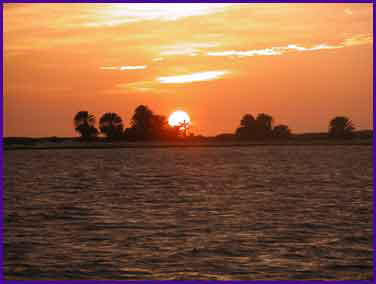 |
We moved a bit further up the reef for a change of
view. The log is full of - eyeballed in over coral, anchored in 8
metres, over sand, in turquoise water, behind small coral island, etc.
It's also full of removed cylinder head from generator, generator shut
down again, etc. But who wants to read (or write) about that! After a few days we anchored behind Francisquis (small coral island, etc). We'd read that it was particularly pretty (it was) and that it was popular with Venezuelan boats up from the mainland - also true, but only two or three. It was also unfortunately just a little too close to Gran Roque, the only inhabited island and home to the Coast Guard base. I should explain. There are no customs or immigration facilities in Los Roques or any of the other islands, so you can't clear in or out there. Coming from the Venezuelan mainland there are two options. The legal way - sail to the islands, buy a cruising permit for 15 days, and then return to the mainland to clear out - ie back to PLC 150 miles against the wind and current or due south to Caracas with 250 murders every weekend, etc. Or the illegal way - clear out of Venezuela for the ABCs and then stop at the islands (2 days allowed at each) and hope not to meet any officials. The second option is the one selected by the vast majority of cruisers, us included. |
| Unfortunately, we drew the short straw in Francisqui and that afternoon a coast guard boat came alongside to check our papers, which they 100% knew in advance weren't going to be in order. It's fair to say that the sergeant in charge of the pirogue was not exactly Mr Happy and he demanded that we sail to Gran Roque to present ourselves to his commanding officer. After a little negotiation (together with some modification of the truth on our part) we agreed that we would present ourselves, at the office of his Jefe at 08.00 the following morning. | |
| The following morning we sailed across and dropped
anchor in the windiest, rolliest and least protected anchorage in Los
Roques. We lowered the dinghy and finally arrived, a little damp
and windswept on the coast guard jetty little more than half an hour late.
This would normally be considered in Venezuela to be on time, though it
wasn't clear from the sergeant's scowl that he agreed. El Jefe on
the other hand was charming. Now we had to go through the careful
choreography which would allow us to give him some money and for him to
allow us to stay, without there ever being even a suggestion that a
bribe was being paid. He duly explained that the regulations only
allowed a vessel in transit to stay for two days (better than the
sergeant's one day, so making progress). We in turn told him that
the islands seemed beautiful, and as we would never have the chance
to return to visit them again, we would really like the opportunity to
see a little more of them. He explained that Los Roques was a
national park and, that even if we were a properly cleared vessel we
would still have to pay the park fee. (Ah, so that's how we got to it.)
Of course we would be happy to pay the park fee, if we were allowed to
stay. Everyone is smiling now (with the possible exception of
sergeant happy) and out from the desk comes a national park permit. Lets be clear here - national park fees are not the
responsibility of the Guardia Costera, but of the Park Rangers (though
we think there are precious few of those left - not a Chavez priority).
There is no way that this "fee" is going to make it any further than El
Jefe's pocket and though nothing will be said, we all know that.
The permit is only for 5 days but is not dated! So we're all friends now. El Jefe takes us over to a chart on the wall to show us all the best anchorages. He then takes us outside to show us where the few shops are - "But" squeals the sergeant "vessels in transit aren't allowed to......" He is silenced by a glare from El Jefe. We inquire where we can dump our garbage. The sergeant is duly despatched to retrieve it from our dinghy and deal with it. |
|
| Half an hour later, with a few manky vegetables and a couple of frozen pork chops from the ubiquitous Chinese supermarket, we've got the anchor up and are on our way west towards our next anchorage at Sarqui. It's only 10 miles and with 20 plus knots of wind behind us we're flying and arrive there in no time. Round the reef and creep in towards the beach. The depth seems to be 4 metres forever and we can probably carry it all the way to the beach, but I chicken out well before that. "Let's drop here." Lindy rolls her eyes as if to say "What, do you like being miles from the beach?" and makes no move towards the windlass. I edge in a couple more boat lengths and then she finally takes pity on my discomfort and walks forward to drop the anchor. Half an hour later another boat comes steaming in past us and drops almost on the beach. Lindy gives me a knowing look! | 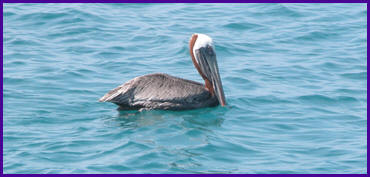 |
| The snorkelling is supposed to be good here, but in reality most of the coral is dead and there are almost no fish. it's the same all through Los Roques. It must have been wonderful here a few years ago, but indiscriminate fishing, anchoring and diving has put paid to a lot of the marine life. Shame the Park Rangers have almost vanished. It seems the marine life is alive on the outside of the reef but as there are no buoys to tie up the dinghy it is not easy to investigate with 20 knots of wind blowing you onto the reef. | |
| The following morning we lift our anchor only to
immediately drop it again. Problem? No it's just that we're
both 100% sure that the yacht sailing north of the reef and getting set
to turn into the bay is the Brasilian boat Kanaloa. Eliza and
Torres our neighbours from Bahia Redonda. They left Puerto La Cruz a
month before us heading north for Puerto Rico. How could they
possibly be here? Well they'd made it as far as Blanquilla where they then sat for 4 weeks waiting for wind. It never came. So a few days earlier with virtually no drinking water left, they made a very definite plan B decision, hoisted the sails and headed towards Los Roques. And here they were! We would sail together for a while now, us making them water periodically until we reached Bonaire (a miracle that the watermaker wasn't playing up for once), them delivering fresh warm bread in return. On next day to Carenero. Recommended to us by El Jefe as the most beautiful anchorage on Los Roques, and we wouldn't disagree. Difficult entrance though, not helped by the fact that both the chart and the way points given by Chris Doyle in his cruising guide are well off. Two other boats arrive, one is the Dutch boat, Jonathan A, who we had seen once or twice, but never spoken to until now and Yves and Jacqueline on the French boat, Imagine, who Eliza and Torres knew from Blanquilla. We were all headed the same way - there's not really any other way to go. We were in danger of becoming a flotilla. |
|
|
| Last stop in Los Roques was to be Cayo de Agua. Not as difficult an entrance as Caranero, but the waters are so coral strewn and the islands so featureless that navigating through them is never relaxing. It turned out to be even more stressful for Kanaloa. We had anchored in the southern side of the archipelago, they decided to check out the northern one. According to the pilot this is small and only carries 8 or 9 feet at the entrance. Kanaloa draws 8! After deciding they didn't much like the look of it they tried to sail directly to our position in the southern anchorage. This took them across a large area of coral marked "not recommended" in our pilot. Finally, they retraced their steps and tried to pick up the primary route that we'd followed. Not always easy without going a long way out. We gave them our way points via VHF, but they clearly didn't have enough time or sea room to allow them to plot them and asked if we could lead them in by dinghy (we have a portable depth gauge). So that's what we did. Torres at the helm, and Barry taking soundings and calling them back to Eliza on the bow. |
|
The French boat then arrived and had
similar problems, so Torres took his dinghy out to guide them in.
The Dutch boat also joined us. Cayo de Aqua is so named because it (allegedly) has water. We didn't find it, but it was late in the season (now June) and the palm trees and other vegetation around some indentations in the ground suggested that if we dug deep enough we might find something. One thing it also has, which makes it a popular destination for tourists from Gran Roque is a beautiful beach and a sand spit that just joins it to the smaller neighbouring island of West Cay. It's quite surreal to walk knee deep to the other island, with turquoise water running in from both sides and nothing to see but sea in either direction. But the novelty wears off after a day or so and it was time to leave the last outpost of Los Roques and head west once again.
|
| 30 or 40 miles west of Los Roques are the final outposts of Venezuela. Islas Las Aves (the bird islands) - two coral encrusted outcrops standing up nearly a kilometre from the surrounding sea bed, a dozen miles apart and each made up of a small handful of mangrove islands. | ||
|
|
The first is Aves Barlovento (windward), uninhabited except for the odd temporary fishing shack. We anchored behind the imaginatively named Isla Sur. Far enough out from the mangroves to avoid the worst of the mosquitoes and protected from the sea by the reef. Aves Barlovento is, as the name suggests, home to an enormous proliferation of sea birds. It's quite an amazing experience at sunset to watch the flocks of different species organising their roosting for the evening. More amazing still is to take the dinghy into the network of lagoons amongst the mangroves. It's like entering a primordial world inhabited only by birds, for the most part silent and completely undisturbed by our presence. Avid twitchers will be excited to learn of the presence here in some numbers of the Red Footed Booby. Now couldn't normally be called upon to tell a Booby from a Gannet but you can tell the Red Footed Boobies, 'cos ........... |
|
| Barlovento is also one of those places where yachties
have taken to leaving something to mark their passing. The
painting of yacht names on the harbour wall at Horta in the Azores is
the most famous. Here on Barlovento there is no wall, so it's been
necessary to construct one and then paint on it or whittle an
imaginative piece of driftwood.
However, even boobies and bits of driftwood pawl after a while, so on to Aves Sotovento. |
||
| This being Venezuela's very, very last
piece of land, is home to a Coast Guard station and on arrival we were
approached by them and shepherded into an extremely shallow bay in the
lee of Isla Larga, to be inspected by El Jefe (no relation). And
inspected we were - very thoroughly - passports, papers, radio
checks, flares, medicine, etc. Very polite (also very young), and
then the moment we'd been waiting for. The very polite (and
young) Jefe took me to one side and told me, very sadly, he had a
problem - hmmm this sounded like it might be expensive! But no,
his problem was that he had twenty men on the island and their
relief ship hadn't arrived, and whilst they had enough rice and water to
keep them alive for a very long time, that was all they did have, and they were going out of their minds with
boredom and couldn't them catch fish between them! You can imagine the conversation each evening - "Que
tenemos para cenar esta noche?" "Te gusta arroz?" "Arroz! Que surprisa,
que bueno mi favorito!".
So did we happen to have any spare tins of anything that had any kind of flavour? Like all boats, we had a large number of dubious tins that had been acquired along the way, just in case, and had been sitting at the bottom of the tin locker ever since. And here was an opportunity to get shot of them and gain some brownie points at the same time. Much thanking and shaking of hands, and of course we were welcome to stay for as long as we liked. Then just as he was about to leave, El Jefe's eyes locked onto the string bag hanging from the targa arch where we keep our onions. "Cebolla! Por favor Seņor, es posible unas cebollas?" We gave him one, truly we only had a couple left. And off they went to visit the other boats. Four boats in one day (our little flotilla) it must have seemed like Christmas - actually five because the motor yacht Diesel Duck (with very big freezers) arrived a little later the same day. Aves Sotovento turned out to be much less interesting than Barlovento. There were for example almost no aves, but instead an exceptionally rich variety of mosquitoes. Time to go! |

